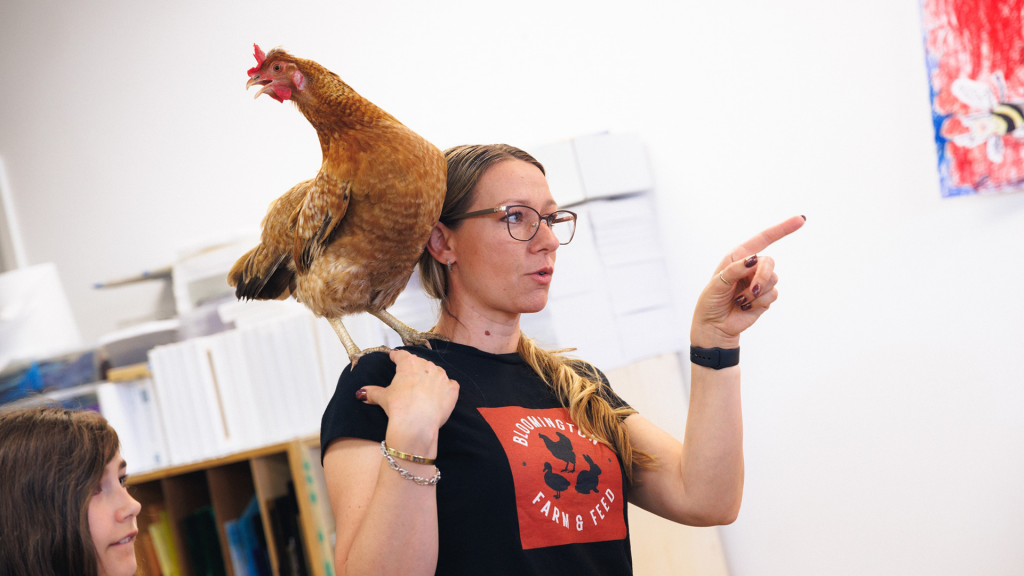America’s backyard chicken boom explained

ST. PAUL, Minn. — Amid ongoing high egg prices and a historic avian flu outbreak, backyard chickens and the local businesses associated with them are thriving.
In Minnesota’s Twin Cities, business owners are feeling the boom. Longstanding local businesses are logging their best year ever for chickens. At the same time, new businesses are popping up offering services like flock sitting and home feed delivery.
“The pandemic year was the best year we ever had for chicks and business, actually,” said Tom Tidrick, owner of Anoka Ramsey Farm and Garden, a family-owned feed and garden shop about 30 minutes outside Minneapolis. “2021 was better than that year. 2022 was better than that year. It stayed really good until this year when we blew through all our sales records.”
And a chicken’s role in a family’s life is shifting. Around 8 million U.S. households considered their chickens pets in 2024, according to the American Pet Products Association (APPA). They come in as the fourth most popular pets after dogs (68 million), cats (49 million) and freshwater fish (10 million).

Feeding the hobby
Like many others, Michelle Zimmer, 44, of Bloomington, Minnesota, started her journey to chicken ownership during the pandemic. She was attracted to urban farming by the idea of consistent access to eggs, and knowing their nutritional makeup.
She started by getting her children chicks in Easter baskets.
Then a family tragedy thrust her into entrepreneurial mode. In December 2022, Zimmer’s husband, Luke, was helping a woman in a snowbank along Interstate 35W in Minneapolis when he was struck by a Toyota Sienna. He underwent surgery for a shattered vertebra and required physical therapy to walk again. Police are still looking for the Toyota driver.
Zimmer needed to care for her husband and find a source of income. She also had to tend her flock. The latter came with its own big demands, often requiring significant travel for chicken feed.
She had an idea — “Instacart for backyard farmers,” she called it — and founded Bloomington Farm and Feed in April 2024. Bloomington Farm and Feed, or BFF, delivers locally sourced feed to backyard farmers. Zimmer also delivers chicks, supplies and coops and even helps with setup.
“All of our feed comes from Minnesota,” Zimmer told Straight Arrow News. “You’re supporting more than just a family-owned business. You’re supporting the people who have the backyards that want a better lifestyle.”
Adding chicken delivery increased revenue by about 40%, she said. And she’s looking to expand, making the leap from internet store to a brick-and-mortar location, which will include a learning space, drop sites for local farmers to bring their products and an artisan marketplace. She recently made the top 10 of Hatch Bloomington, a retail pitch competition that awards winners $100,000 to help grow their businesses.

Chicken scratch
Zimmer’s rising demand mirrors national trends. Karen Callahan, a spokeswoman for nationwide retailer Tractor Supply, said the company does not release details on sales figures, but was on track for a record-breaking year.
“We sold about 11 million chicks in 2024, and this year we’ve seen an uptick in new flock owners, as well as a steady increase in business from existing customers,” Callahan told Straight Arrow News.
Johanna Lies, assistant manager at Egg|Plant Urban Farm Supply in St. Paul, Minnesota, said her store has felt the same bump.
“There was increased demand pretty much across the board because of avian flu and when egg prices were going kind of crazy this year,” Lies told SAN.
Egg|Plant, a backyard-homesteading supply shop that opened in 2010, sold more than 3,600 chicks this year. Customers came from as far away as North Dakota. Sales are up from 2024, but shortages from their hatchery — part of a broader trend caused by avian flu — meant Egg|Plant had to limit orders.
“I think we probably would have ordered a lot more if we could,” Lies said.

What caused the chicken boom?
Ownership of backyard chickens nearly tripled at the onset of the COVID-19 pandemic. Around 5.8 million households owned backyard chickens in 2018. That figure spiked to more than 15 million households in 2020, according to the APPA.
Then came a correction: flocks tapered off to fewer than 10 million households in 2023. But the egg shortage brought on by avian flu drove a 2024 rebound to about 11 million households.
Andrew Pekosz, a professor in immunology and microbiology at Johns Hopkins University specializing in respiratory viruses, said a particularly nasty strain of H5N1 — commonly known as avian flu — has persisted since February 2022.
Avian flu spreads through fecal matter that contaminates food or water, and primarily infects the intestinal tracts of birds.
“In wild birds, avian flu doesn’t do much,” Pekosz said. “It sort of evolved with those wild birds. It doesn’t cause too much damage. They can fly while they’re infected.”
However, poultry such as commercial and hobby chickens and turkeys have not built up that natural resistance. As a result, avian flu is almost always fatal, Pekosz told SAN. Generally, once a flock of any size is infected, the entire flock must be culled to prevent the spread of disease to other livestock or humans.
“If you’re seeing your birds get very sick, the virus is probably everywhere,” Pekosz said. “Touch base with state departments of agriculture so you know the procedure for getting rid of the birds and disinfecting the entire area so you can safely repopulate poultry flock.”
Part of what makes the latest H5N1 outbreak so dangerous to poultry is the virus’ ability to infect multiple species, Pekosz said.
“Normally there’s not a huge number of cases and it stays within species,” Pekosz said. “This H5N1 doesn’t seem to care too much about the species”
The result is nearly 170 million dead commercial and backyard birds, either through infection or culling. A total of 70 cases have been found in humans, including the death of a backyard chicken farmer in Louisiana.
The disease has wrought havoc on the poultry industry, resulting in shortages of both chicks and eggs.
According to the Federal Reserve of St. Louis, a dozen Grade A large eggs cost around $1.92 in January 2022 before H5N1 spread worldwide. That jumped to $4.82 in January 2023 and became a focal point during the 2024 presidential election. Prices topped out at around $6.23 in March. By June, the price settled to around $3.78.
Business incubation
Craig and Dana Heinen, both 37, of Richfield, Minnesota, opened Flock Sitting MN this year. The couple, who primarily raise ducks but also have Esty, a Polish chicken, provide basic check-ins for Twin Cities chicken owners who can’t tend to their flock.
Think of it as chicken sitting. The service includes a 15-minute check-in, refilling food and water, collecting and storing eggs, cleaning the bedding as necessary and a perimeter check. The Heinens also offer more detailed services such as coop inspections and winter wrapping.
Some municipalities, such as Minneapolis, require would-be backyard chicken owners to complete a fowl education course. The Heinens offered their first class this spring. Twenty people signed up for the first class.

What to consider when starting your backyard flock
While the allure of saving money on eggs draws many into the backyard chicken hobby, it’s a bit misleading.
“I’m quick to tell people getting a backyard flock isn’t necessarily going to save you money on eggs, but it will ensure you know where they’re coming from,” said Lies, the Egg|Plant assistant manager.
It is also much more difficult than just putting a few birds in the backyard.
Chickens are social animals and should be raised in groups, according to Dana Heinen. A flock of three or four is a good starting number. Breeds like White Leghorns and Rhode Island Reds are classic egg-layers while breeds like Bantams and Silkies lay less frequently.
Space is also a must, Dana. Heinen told SAN. She recommends budgeting about 4 or 5 feet of space per bird when planning coop size, and 10 square feet per bird when allocating run span. The space, including the ground, must also be properly prepared to prevent rodents and vermin from infiltrating the coop. Heinen prefers hardware cloth over chicken wire for this, at a cost of about $15 per 10 square-foot.
Feed can run $20 a week, depending on the type, according to Lies.
Coops can also vary widely in cost, from $100 to upwards of $1,000. There is also the option of building your own, which requires planning, materials costs and labor.
Speaking of labor, Heinen said it is important to remember chickens are not a set-it-and-forget-it animal. Backyard farmers have to feed the chickens, collect eggs, socialize with the animals and clean the bedding.
Chickens can also live between five and 10 years, depending on the breed, Lies said. Prime egg-laying age starts around 4-5 months until they are 4-5 years old. Supplemental light will also be needed to keep chickens laying through darker months.
All that will result in about a dozen to two-dozen eggs a week while the birds are in laying age, Lies said.
“It’s not necessarily cheaper, but it is a reliable way to get eggs,” she said.
Municipal laws also vary across the country. Most major cities allow backyard flocks, but requirements and limits are scattered, even within the same state.
For instance, both Minneapolis and neighboring St. Paul allow backyard flocks. However, Minneapolis allows up to 30 hens for an $84 annual permit while St. Paul caps the flock at 15 hens for a $76 initial permit fee, which must be renewed annually for $28. Cities such as Los Angeles and Dallas do not impose any restrictions on flock size or require permits while cities such as Philadelphia and Miami do not allow backyard flocks at all.
Roosters are also generally forbidden, but municipal laws once again vary. St. Paul does not allow roosters while Minneapolis does for a $100 fee.





